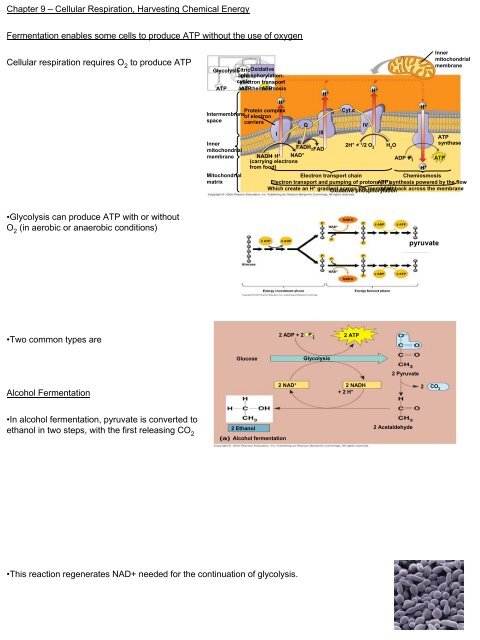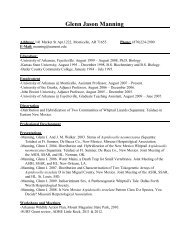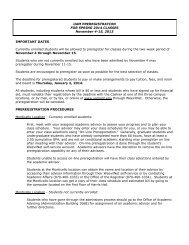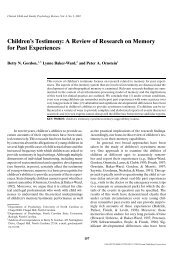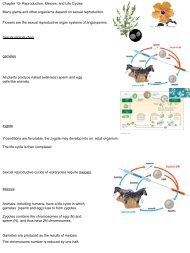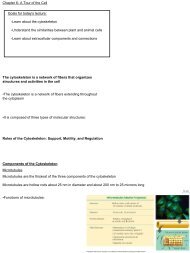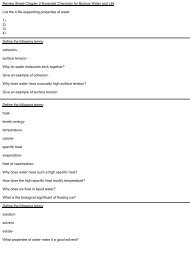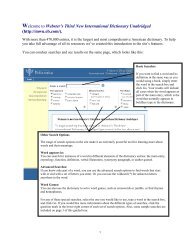Cellular Respiration, Harvesting Chemical Energy Fermentation ...
Cellular Respiration, Harvesting Chemical Energy Fermentation ...
Cellular Respiration, Harvesting Chemical Energy Fermentation ...
You also want an ePaper? Increase the reach of your titles
YUMPU automatically turns print PDFs into web optimized ePapers that Google loves.
Chapter 9 – <strong>Cellular</strong> <strong>Respiration</strong>, <strong>Harvesting</strong> <strong>Chemical</strong> <strong>Energy</strong><br />
<strong>Fermentation</strong> enables some cells to produce ATP without the use of oxygen<br />
<strong>Cellular</strong> respiration requires O 2<br />
to produce ATP<br />
Glycolysis CitricOxidative<br />
acid phosphorylation:<br />
cycle electron transport<br />
ATP and ATPchemiosmosis<br />
H +<br />
Protein complex<br />
Intermembrane<br />
of electron<br />
space carriers<br />
Inner<br />
mitochondrial<br />
membrane<br />
Mitochondrial<br />
matrix<br />
I<br />
H +<br />
Q<br />
III<br />
II<br />
FADH 2FAD<br />
Cyt c<br />
Inner<br />
mitochondrial<br />
membrane<br />
NADH+ H + NAD +<br />
ADP + P<br />
(carrying electrons<br />
i ATP<br />
from food)<br />
H +<br />
Electron transport chain<br />
Chemiosmosis<br />
Electron transport and pumping of protons ATP (H + ), synthesis powered by the flow<br />
Which create an H + gradient Oxidative across phosphorylation<br />
the membrane of H + back across the membrane<br />
IV<br />
2H + + 1 /2 O 2<br />
H +<br />
H 2 O<br />
H +<br />
ATP<br />
synthase<br />
•Glycolysis can produce ATP with or without<br />
O 2<br />
(in aerobic or anaerobic conditions)<br />
pyruvate<br />
•Two common types are<br />
2 ATP<br />
2 ADP + 2 P i<br />
2 Pyruvate<br />
Glucose<br />
Glycolysis<br />
Alcohol <strong>Fermentation</strong><br />
2<br />
CO 2<br />
•In alcohol fermentation, pyruvate is converted to<br />
ethanol in two steps, with the first releasing CO 2<br />
2 Ethanol<br />
Alcohol fermentation<br />
2 NAD + 2 NADH<br />
+ 2 H +<br />
2 Acetaldehyde<br />
•This reaction regenerates NAD+ needed for the continuation of glycolysis.
Lactic Acid <strong>Fermentation</strong><br />
In lactic acid fermentation,<br />
Glucose<br />
2 ATP<br />
Glycolysis<br />
2 NAD +<br />
2 NADH<br />
+ 2 H +<br />
2<br />
CO 2<br />
2 ADP + 2 P i<br />
2 Pyruvate<br />
2 Lactate<br />
Lactic acid fermentation<br />
•Lactic acid fermentation by some<br />
fungi and bacteria is used to<br />
make cheese and yogurt<br />
Lactic Acid <strong>Fermentation</strong> in Human Muscle Cells<br />
•Human muscle cells use lactic acid fermentation to generate ATP when O 2<br />
is scarce<br />
When you walk to class, ATP powers muscles cells of your legs.<br />
<strong>Cellular</strong> respiration regenerates ATP supply to keep you going.<br />
If you start to run to class,<br />
In order to keep running, your muscles must generate ATP by the anaerobic process of fermentation.<br />
NAD+ must also be present as an electron acceptor for glycolysis to occur.<br />
2 pyruvate
Lactic Acid <strong>Fermentation</strong> in Human Muscle Cells<br />
NAD+ is present under aerobic condition of cellular respiration.<br />
NAD+ is regenerated by the cell<br />
NAD+ cannot be recycled by the cell under anaerobic conditions,<br />
2 pyruvate<br />
This addition of electrons produces the waste product, lactic acid.<br />
Glucose<br />
2 NAD + 2 NADH<br />
2<br />
+ 2 H +<br />
2 Pyruvate<br />
CO 2<br />
2 ADP + 2 P i 2 ATP<br />
Glycolysis<br />
2 Lactate<br />
Lactic acid fermentation<br />
<strong>Fermentation</strong> and <strong>Cellular</strong> <strong>Respiration</strong> Compared<br />
•Both processes use glycolysis to oxidize glucose and other organic fuels to pyruvate<br />
2 ADP + 2 P i<br />
2 Pyruvate<br />
pyruvate<br />
Glucose<br />
2 ATP<br />
Glycolysis<br />
2 NAD +<br />
2 NADH<br />
+ 2 H +<br />
2<br />
CO 2<br />
2 Lactate<br />
Lactic acid fermentation
<strong>Fermentation</strong> and <strong>Cellular</strong> <strong>Respiration</strong> Compared<br />
The processes have different final electron acceptors:<br />
2 ADP + 2 P i<br />
2 Pyruvate<br />
Glucose<br />
2 ATP<br />
Glycolysis<br />
2 NAD +<br />
2 NADH<br />
+ 2 H +<br />
2<br />
CO 2<br />
Glucose<br />
2 ADP + 2 P i 2 ATP<br />
Glycolysis<br />
2 Pyruvate<br />
2 NAD + 2 Acetaldehyde<br />
2 NADH<br />
+ 2 H +<br />
2<br />
CO 2<br />
2 Lactate<br />
Lactic acid fermentation<br />
2 Ethanol<br />
Alcohol fermentation<br />
The processes have different final electron acceptors:<br />
Inner<br />
mitochondrial<br />
Glycolysis Citric Oxidative<br />
membrane<br />
acid phosphorylation:<br />
cycle electron transport<br />
ATP ATP and chemiosmosis ATP<br />
H +<br />
H +<br />
H +<br />
H<br />
Protein complex<br />
Cyt c<br />
+<br />
Intermembrane<br />
of electron<br />
space<br />
carriers<br />
Q<br />
IV<br />
I<br />
III<br />
ATP<br />
Inner<br />
II<br />
FADH 2H + + 1 /2 O<br />
mitochondrial<br />
2 FAD<br />
2 H 2 O<br />
synthase<br />
membrane<br />
NADH+ H + NAD +<br />
(carrying electrons<br />
ADP + P i ATP<br />
from food)<br />
H +<br />
Mitochondrial<br />
Electron transport chain<br />
Chemiosmosis<br />
matrix<br />
Electron transport and pumping of protons (H + ), ATP synthesis powered by the flow<br />
Which create an H + gradient<br />
Oxidative<br />
across the<br />
phosphorylation<br />
membraneof H + back across the membrane<br />
•<strong>Cellular</strong> respiration produces much more ATP<br />
Some organisms can carry out only fermentation (anaerobic respiration).<br />
Yeast and many bacteria are facultative anaerobes,<br />
Glucose<br />
In a facultative anaerobe,<br />
CYTOSOL<br />
Pyruvate<br />
No O 2 present<br />
<strong>Fermentation</strong><br />
O 2 present<br />
<strong>Cellular</strong> respiration<br />
Ethanol<br />
or<br />
lactate<br />
Acetyl CoA<br />
MITOCHONDRION<br />
Citric<br />
acid<br />
cycle
The Evolutionary Significance of Glycolysis<br />
Glycolysis occurs in nearly all organisms<br />
Membrane-bound organelles<br />
Accumulation of atmospheric<br />
oxygen from photosynthetic<br />
cyanobacteria<br />
Oldest prokaryotic fossils<br />
Earth cool enough for crust to solidify<br />
Origin of Earth<br />
Glycolysis and the citric acid cycle connect to many other metabolic pathways<br />
•Gycolysis and the citric acid cycle are major<br />
intersections to various catabolic and anabolic<br />
pathways<br />
The Versatility of Catabolism<br />
Catabolic pathways funnel electrons from many<br />
kinds of organic molecules into cellular respiration<br />
Proteins<br />
Carbohydrates<br />
Fats<br />
Proteins must be digested to amino acids;<br />
Amino<br />
acids<br />
Sugars<br />
Glycerol Fatty<br />
acids<br />
Glycolysis<br />
Glucose<br />
Glyceraldehyde-3- P<br />
NH 3<br />
Pyruvate<br />
Acetyl CoA<br />
Citric<br />
acid<br />
cycle<br />
Oxidative<br />
phosphorylation
Regulation of <strong>Cellular</strong> <strong>Respiration</strong> via Feedback Mechanisms<br />
•Feedback inhibition is the most common mechanism for<br />
control of glycolysis and the Krebs Cycle.<br />
If ATP concentration begins to drop, respiration speeds up;<br />
when there is plenty of ATP, respiration slows down<br />
Glucose<br />
–<br />
Glycolysis<br />
Fructose-6-phosphate<br />
Phosphofructokinase<br />
AMP<br />
Stimulates<br />
+<br />
–<br />
Inhibits<br />
Fructose-1,6-bisphosphate<br />
Inhibits<br />
Phosphofructokinase is an<br />
allosteric enzyme with receptor<br />
sites for specific inhibitors<br />
and activators.<br />
Fructose-6-phosphate<br />
ATP<br />
Phosphofructokinase<br />
Pyruvate<br />
ADP<br />
ATP<br />
Acetyl CoA<br />
Citrate<br />
Fructose-<br />
1, 6-bisphosphate<br />
Citric<br />
acid<br />
cycle<br />
Allosteric Regulation of Enzymes<br />
Oxidative<br />
phosphorylation<br />
Allosteric regulation is the term used to describe cases where a<br />
Allosteric regulation may either inhibit or stimulate an enzyme’s activity<br />
Allosteric enzyme<br />
with four subunits<br />
Active site<br />
(one of four)<br />
Allosteric activator<br />
stabilizes active form.<br />
Most allosterically regulated enzymes are made from polypeptide subunits<br />
Regulatory<br />
site (one<br />
of four)<br />
Active form<br />
Activator<br />
Stabilized active form<br />
Oscillation<br />
Allosteric inhibitor<br />
stabilizes inactive form.<br />
Nonfunctional<br />
active site<br />
Inactive form Inhibitor Stabilized inactive<br />
form<br />
Allosteric activators and inhibitors
Regulation of <strong>Cellular</strong> <strong>Respiration</strong> via Feedback Mechanisms<br />
–<br />
Glucose<br />
Glycolysis<br />
Fructose-6-phosphate<br />
Phosphofructokinase<br />
AMP<br />
Stimulates<br />
+<br />
–<br />
Inhibits<br />
Fructose-1,6-bisphosphate<br />
Inhibits<br />
Phosphofructokinase is also sensitive to citrate production<br />
in the Krebs Cycle.<br />
Pyruvate<br />
If citrate accumulates in the mitochondria,<br />
ATP<br />
Acetyl CoA<br />
Citrate<br />
Citric<br />
acid<br />
cycle<br />
Oxidative<br />
phosphorylation<br />
Study outline-Chapter 9-<strong>Cellular</strong> <strong>Respiration</strong><br />
-Understand the two common types of fermentation (Fig. 9.18)<br />
-alcohol fermentation<br />
-lactic acid fermentation<br />
-What types of processes use alcohol fermentation?<br />
-Understand how fermentation works in human muscle cells.<br />
-Know terms-anaerobic, fermentation<br />
-What metabolic pathway provides ATP during fermentation?<br />
-Why can’t NAD+ be recycled by the cell under anaerobic conditions?<br />
-What waste product that is produced in the fermentation process in muscle cells?<br />
-What waste products are produced in the fermentation of yeast?<br />
-Understand similarities and differences between fermentation and cellular respiration<br />
-Know terms-obligate anaerobes<br />
-facultative anaerobes (Fig. 9.19)<br />
-Understand the evolutionary significance of glycolysis<br />
-Understand how glycolysis and the citric acid cycle connect to other metabolic pathways (Fig. 9.20)<br />
-Understand the regulation of cellular respiration via feedback mechanisms (Fig. 9.21)<br />
-Know terms-allosteric enzymes


